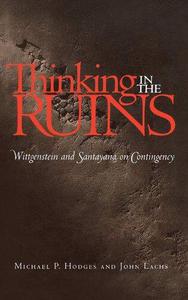
Thinking in the Ruins: Wittgenstein and Santayana on Contingency By Michael P. Hodges, John Lachs
2000 | 144 Pages | ISBN: 0826513417 | PDF | 7 MB
While Ludwig Wittgenstein (1889-1951) and George Santayana (1863-1952) may never have met or even have studied one another's work, they experienced similar cultural conditions and their thinking took similar shapes. Yet, until now, their respective bodies of work have been examined separately and in isolation from one another. Santayana is often regarded as an aesthetician and metaphysician, but Wittgenstein's work is usually seen as antithetical to the philosophical approaches favored by Santayana. In this insightful new study, Michael Hodges and John Lachs argue that behind the striking differences in philosophical style and vocabulary there is a surprising agreement in position. The similarities have largely gone unnoticed because of their divergent styles, different metaphilosophies, and separate spheres of influence. Hodges and Lachs show that Santayana's and Wittgenstein's works express their philosophical responses to contingency. Surprisingly, both thinkers turn to the integrity of human practices to establish a viable philosophical understanding of the human condition. Both of these important twentieth-century philosophers formed their mature views at a time when the comfortable certainties of Western civilization were crumbling all around them. What they say is similar at least in part because they wished to resist the spread of ruin by relying on the calm sanity of our linguistic and other practices. According to both, it is not living human knowledge but a mistaken philosophical tradition that demands foundations and thus creates intellectual homelessness and displacement. Both thought that, to get our house in order, we have to rethink our social, religious, philosophical, and moral practices outside the context of the search for certainty. This insight and the projects that flowed from it define their philosophical kinship. Thinking in the Ruins will enhance our understanding of these monumental thinkers' intellectual accomplishments and show how each influenced subsequent American philosophers. The book also serves as a call to philosophers to look beyond traditional classifications to the substance of philosophical thought.
https://www.uploadcloud.pro/3dozigawlu9q/wkf3v.T.i.t.R.W.a.S.o.C.rar.html

https://rapidgator.net/file/d93356f7fd10eeb31f654930aebf63a3/wkf3v.T.i.t.R.W.a.S.o.C.rar.html

https://nitroflare.com/view/E9F36B6F1EA0D85/wkf3v.T.i.t.R.W.a.S.o.C.rar

https://uploadgig.com/file/download/42950982d0056366/wkf3v.T.i.t.R.W.a.S.o.C.rar
